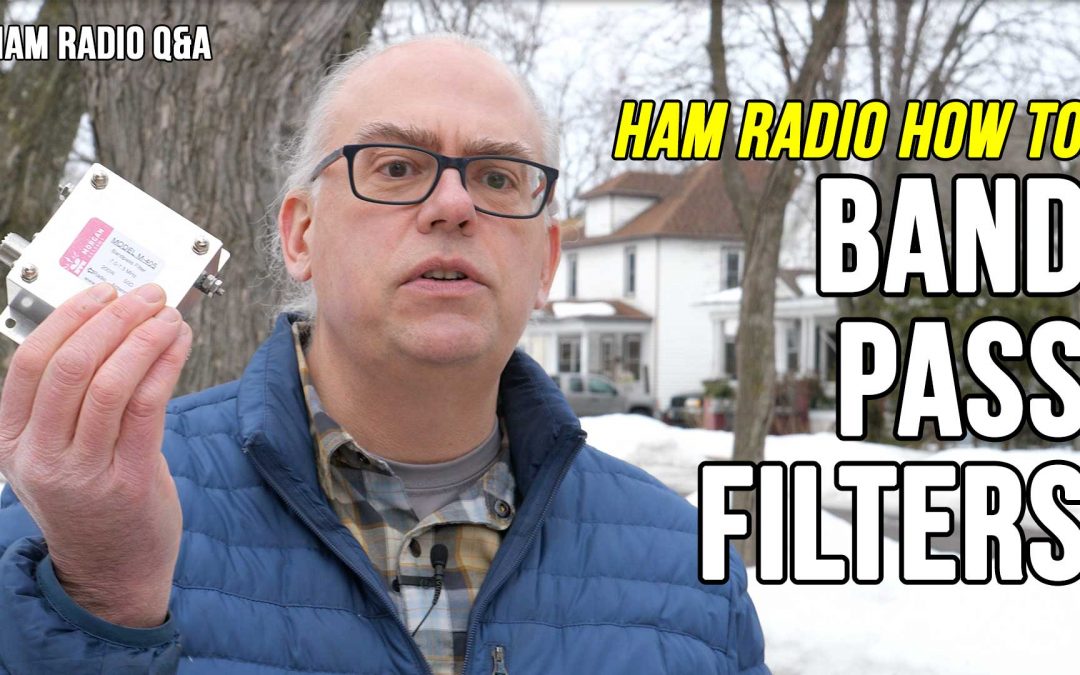Do you want to do a group activation or field day operation without stepping on or covering each other up? Band Pass Filters to the rescue!
Filtering is an important component of an amateur radio transceiver. We often talk about ‘weak filters’ or front end overload when describing the characteristics of inexpensive transceivers. In fact all transceivers require filtering of some sort. Modern transceivers have digital signal processing that can employ a wide range of filter bandwidths and shapes and older transceivers will use analog or mechanical filters to limit the amount of signal entering into the receiver.
But the filtering built into a transceiver can only do so much and sometimes we need to add accessory filters to block out a range of frequencies. There are three types of filters that do thatL: high pass, low pass, and band pass.
High Pass Filters allow frequencies of a range above the filter’s set frequency to pass through. Typically a high pass filter will be set to about 1.8 Mhz and let frequencies above this range to pass to the transceiver. They are commonly used if you have a powerful AM broadcast station close by that is interfering and you want to block their signal.
Low pass filters allow frequencies of a range below the filter’s set frequency to pass through. Typically a low pass filter is set to about 30 Mhz and will let frequencies below that range to pass to the transceiver. They are used to block out spurs and spurious emissions from your transmitter that may be interfering with televisions or other receivers, especially if you are running an amplifier. Low pass filters used to be quite common in the days of analog television, but now with digital TV and broadcast frequencies up in UHF range, they really aren’t as necessary.
Band Pass filters combine the low and high pass to allow just a certain range of frequencies to pass through. Usually they are set for a particular band, like the 20 meter band, so you can transmit and receive on that band and not affect transmitters on other bands. But some band pass filters can be very tight; for example, a VHF filter may be used at a repeater site to allow the repeater’s frequency to pass through and block out all other VHF transmitters that may be located on the same communication tower.
How does a filter work? A filter is a tuned circuit with inductors and a capacitor. This is a tuned circuit, so the filter’s cutoff frequency and passband can be adjusted by the amount of inductance and capacitance in the circuit. If we look at a filter, you may think that the construction is sloppy, but in reality all the hot glue is holding the inductor precisely in place for the proper cutoff frequency.
In a low pass filter, the inductor is in the circuit and the capacitor runs to ground. Conversely in a high pass filter, the inductor runs to ground and the capacitor is part of the circuit. That distinction is notable, because if we combine the two, we end up with a band pass filter. By adjusting the capacitance and inductance on both ends, we can precisely set the cutoff frequency for the filter. Signals inside the passband will be allowed through the filter and outside the passband will be cut off.
It’s important to know that this is a tuned circuit. You can transmit through the filter if your transmit frequency is within the passband. But you can also damage any of these filters if you transmit outside their specified range. The filter is going to want to attenuate everything outside its passband, so the filter will do its darndest, even to death, to keep the energy from passing. For example, if you have a 20 meter band pass filter, transmitting on the 40 meter band will most likely damage it.
So why do I like band pass filters? Band pass filters are vital If I’m out doing a Parks on the Air activation with friends. We can operate on different bands in close proximity to each other and keep interference to a minimum. They won’t block out everything, but they are good enough that you can copy weak stations on 20 meter phone without having that 40m FT8 signal blasting through. If you are setting up for field day, band pass filters are essential for everyone getting along. Any time you have stations and antennas in close proximity, you need an external filter. But you do need to remember to remove or change the filter if you change bands. So if you bring your filters out to field day, a bit of education to other operators will be in order.
The filters I use aren’t that expensive. This one from Morgan Systems is about $80. I have three in my arsenal, one for 40, 20, and 15 meters. If I only had money for one, I’d start with the 40 meter band and slowly work in the others. My collection has grown over the past few years. Usually I realize a need and then get another filter. So you don’t have to buy a full set all at once.
So filtering, especially with band pass filters, can be extremely useful out in the field and with group ham radio activities. Are you a filter user? What are your experiences, please share them down in the comments.
Morgan Systems Band Pass Filters:
http://www.surgestop.com
Like what you see? You can leave me a tip:
https://www.paypal.me/kb9vbr
Become a patron! Unlock exclusive content at: https://www.patreon.com/kb9vbrantennas
Support Ham Radio Q&A by shopping at Amazon: http://amzn.to/2kO6LH7

Recent Comments